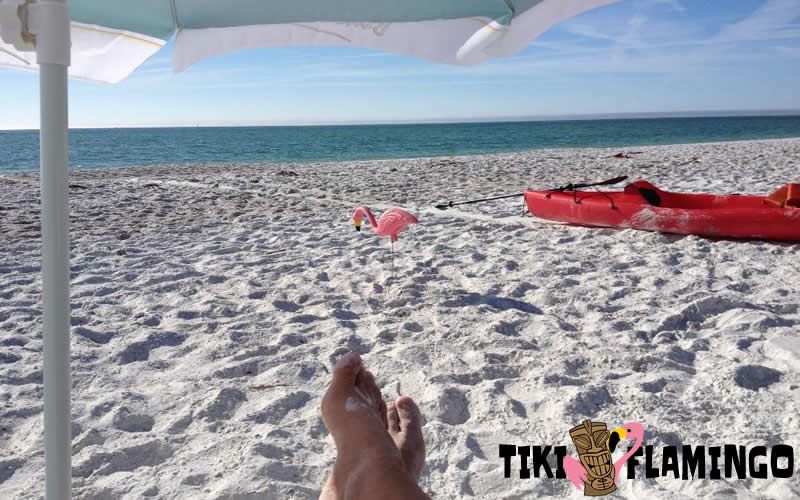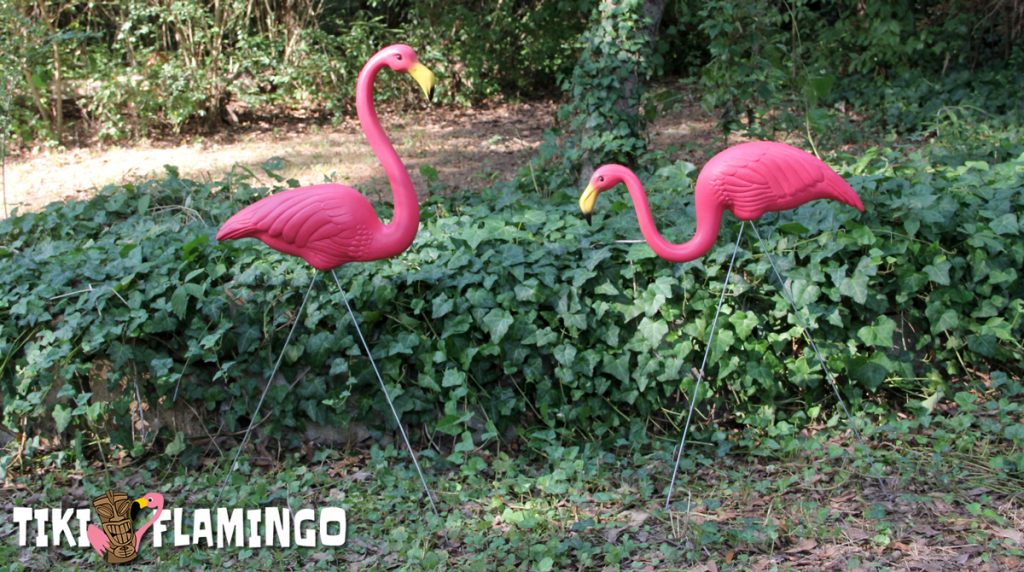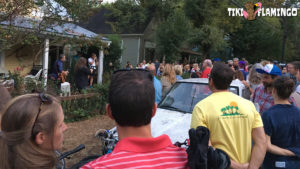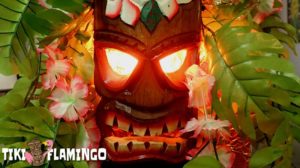Whether you consider it an annoying symbol of tackiness or a fun piece of yard kitsch, you have to admit that the pink plastic flamingo yard ornament is an iconic piece of American pop culture.
Plastic flamingos can be found everywhere. You see them in front lawn displays, backyard barbecues, pool parties, outdoor concerts, even campsites. Their metal legs have been stuck into snow and sand and everything in between.
The yard ornament has also withstood the test of time. Over its sixty year history, a clear meaning has become attached to the blow-molded bird: where there is a plastic pink flamingo, there is undoubtedly someone nearby who has a sense of humor.
The Birth of the Plastic Pink Flamingo
Designed by American sculptor Don Featherstone in 1957, the pink plastic lawn ornament became an overnight success for Union Products, the Massachusetts-based company where Don worked.
Utilizing plastics technology developed during World War II, Union Products sought to make fun and affordable “Plastics for the Lawn”. With home ownership and the post-war economy booming due to the GI Bill and other government programs, the middle class exploded into suburban neighborhoods. All these new homes had lawns, and those lawns needed decoration.
Don Featherstone was first commissioned to create a three-dimensional version of the companies very popular two-dimensional duck ornament. This sold well, so next he turned his creative eye on another of the company’s popular 2-D figures, a pink flamingo.
Don wanted the flamingo to have wooden legs, but to avoid extra production expense, the company went with the thin wire legs we now associate with the plastic flamingo. Some would argue that the thin wire legs added to the humor of the figurine and, in turn, the kitschy, pop art appeal. There is a certain ridiculousness to the cheap approach to legs for the beautifully sculpted lawn ornament.
Perhaps more than anything, this ridiculousness is the key to the popularity of the plastic pink flamingo yard ornament. For a few bucks anyone with a plot of soil in front of them could erect a pair of plastic flamingos and magically transform the area into a exotic, tropical destination. Plastic flamingos were cheap, fun, and, most importantly, funny.
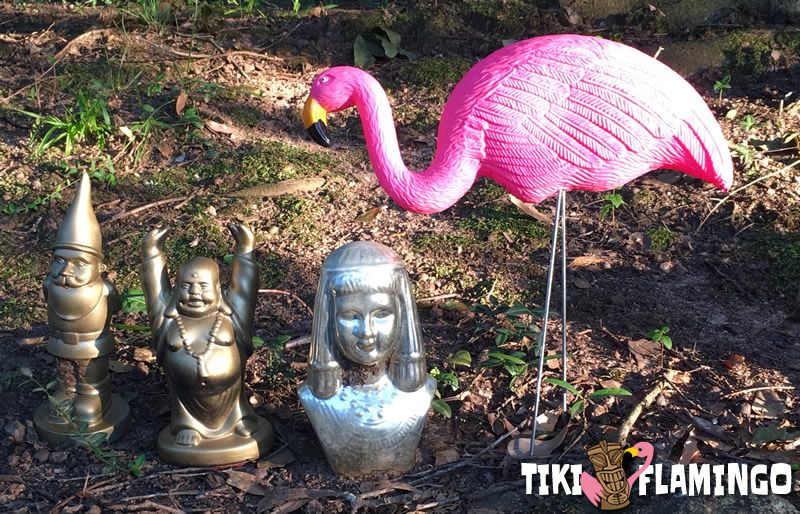
A Cultural History of the Pink Plastic Flamingo
Given the scientific name phoenicopteris ruber plasticus by its creator, the pink plastic flamingo’s kitsch appeal can be traced through its storied existence. Let’s go over some some key events in American culture that helped propel this cheap plastic lawn figurine into a pop culture history.
A Portable Tropical Vacation
Americans were starting to travel the country more in the 1950s due to the booming economy and much improved highway system. Due to it’s warm, sunny weather and tropical ambience, Florida became the prime vacation hotspot for this new class of wandering suburbanites.
The Sunshine State offered middle class Americans an exotic yet affordable destination to pin their vacation dreams on. And there was no better symbol of this exotic, tropical wonderland than the flamingo.
If you couldn’t afford to go to Florida on your vacation, you could at least set loose a pair of pink plastic flamingos in your yard, sit in your lawn chair with a fancy drink, and pretend you were there. And if you had made the pilgrimage, plastic flamingo yard ornaments were the perfect way to cheaply relive your Florida vacation in your own backyard.
An Endangered Species
The late 1960s, however, was a tough era for the plastic pink flamingo. With a growing youth movement that was both environmentally conscious and distrustful of domestic trappings, the plastic lawn ornament lost its cultural appeal. Sales dwindled and the outlook for the frivolously fun lawn ornament looked bleak.
But the fake plastic bird that was seemingly becoming an anathema to emerging sensibilities that celebrated the real and the natural would, in the end, skirt extinction and go on to thrive in the collective American psyche.
A Counterculture Icon
The 1970s saw a huge revival of the plastic yard bird, albeit one that cemented its tacky, working-class place in pop culture. The plastic pink flamingo would become de rigueur yard decor for mobile homes, low rent hovels, and any sort of temporary dwelling.
The biggest contributor to this new identity for the plastic pink flamingo was the 1972 John Waters film, Pink Flamingos. This counterculture classic follows self-proclaimed “filthiest person alive,” Babs Johnson (Divine) and a cast of outcasts as they spiral downward into new depths of depravity and grotesquerie. The title of the film seems to imply that you can recognize the entrance to this otherworld of debauchery and decadence by the pair of pink plastic flamingos that stand at the gateway.
But this new identity as a harbinger of bad taste wasn’t exactly negative for the plastic pink flamingo. The lawn ornament became a symbol for the disaffected downtrodden and a humorous way to mock the unreachable promise of the American Dream. A plastic flamingo in your yard could be seen as a sign of defiance and disobedience to the absurdity of the system.
The socio-political irreverence of the pink flamingo lawn ornament made it the perfect vehicle for a prank by cheeky University of Wisconsin students celebrating a takeover of the student government. On September 4th, 1979, members of the absurdist “Pail and Shovel” party installed 1,008 plastic flamingos on the lawn in front of the dean’s office on Bascom Hill after winning reelection for the head of the Wisconsin Student Association.
This is the same group that famously used a portion of the student government budget to recreate the top of the Statue of Liberty on frozen Lake Mendota, the implication being that Lady Liberty had been purchased and moved to the lake and only the top of her head and torch-bearing arm were visible.
The plastic avian yard ornament became such a symbol for the humor and irreverence for the city, that in 2009, Madison, Wisconsin city council voted 15 to 4 to make the plastic flamingo the official city bird. One of the original Bascom Hill flamingos is even on permanent display at the Madison Historical Society.
New Fashion Brings New Meaning
The 1980s were even kinder to the plastic pink flamingo. It was an era that embraced both tackiness and bright, vivid colors.
Tropical pastels and flowered Hawaiian shirts became all the rage as TV shows Magnum P.I. and Miami Vice became a nationwide hits. A retro fashion sensibility that borrowed from the colorful look of the late 50s and 60s also fueled this “new wave” style when bands like The B-52s, Culture Club, and Duran Duran were broadcast into homes across America via MTV, the pay music television network.
The flamboyant and tropical pink flamingo fit right into this new fashion paradigm and the lawn ornament was given a new mainstream dignity that softened its counterculture reputation. The plastic pink flamingo simply symbolized fun, playful kitsch to this new generation of financially-optimistic youth.
Because so many imitation plastic flamingos were hitting the market, in 1987, Union Products added Don Featherstone’s signature to the underside of their plastic flamingos to signify that these were indeed the genuine and original yard ornaments. That year was also the 30th anniversary of the plastic flamingo.
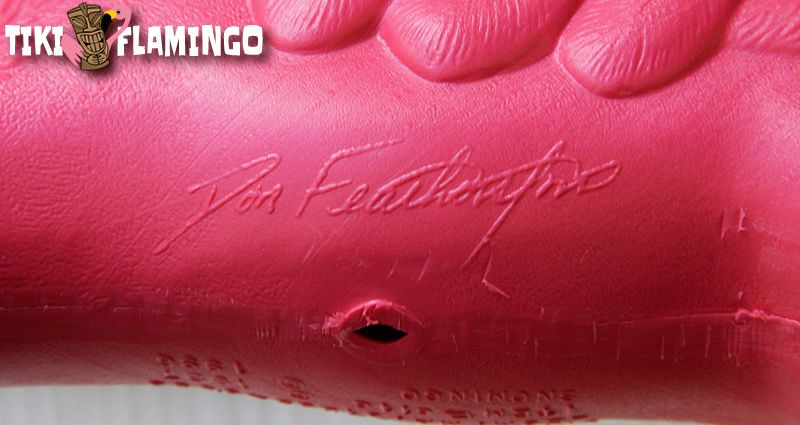
A Recognized Pop Art Icon
In 1996, the Annals of Improbable Research awarded Don Featherstone with the “lg Nobel” Prize for Art. Not to be confused with a more recognized prize with a similar name, this dubious distinction honors “achievements that first make people laugh, and then make them think.”
The following year, on the 40th anniversary of the plastic pink flamingo, Don Featherstone reached out to devotees of the yard ornament asking them to submit original photographs of their flock. More than one hundred of these images were compiled in the book The Original Pink Flamingos: Splendor on the Grass which hit bookshelves in the fall of 1999.
An Era of Change for the Plastic Flamingo
In 2000, Don Featherstone retired from Union Products, Not long after this, the company altered the molds of the plastic flamingos, removing his signature from the undersides.
In December 2001, The Museum of Bad Art and the aforementioned Annals of Improbable Research lead a boycott of Union Products in protest of the signature removal.
The boycott was successful and the signature replaced, but even the added publicity of the affair was not enough to save Union Plastics. It officially closed its doors in 2006.
But apparently the invincible plastic flamingo has more lives than a cat. In 2007, Cado Company bought the molds and the rights to the yard ornament and right away began production – with Don Featherstone’s signature intact. To this day, Cado is producing the original, authentic Don Featherstone design flamingos.
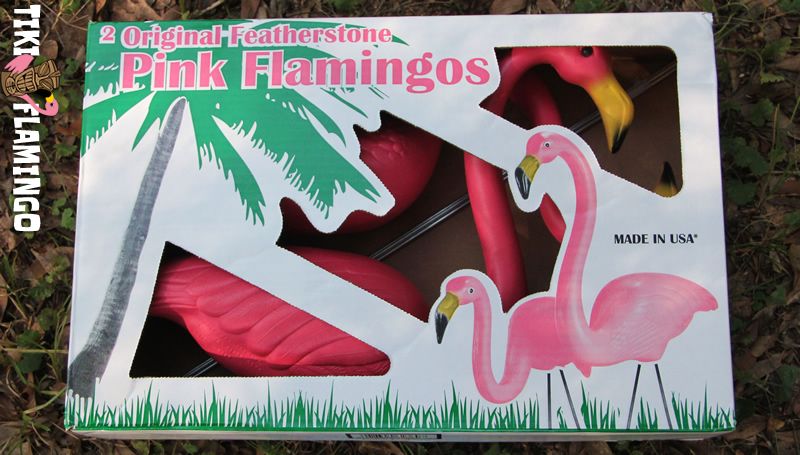
Don Featherstone passed away on June 22, 2015 at the age of 79, but his original plastic pink flamingo lawn ornament lives on in the hearts, minds, and yards of people around the world.
The Care and Feeding of the Plastic Flamingo
Fortunately, keeping this important species of American pop culture alive and well is easy. Just purchase a pair (or more) and set them free in your front yard. Pretty soon they will propagate into a nearby neighbor’s yard and in no time, your neighborhood will become an ideal habitat for phoenicopteris ruber plasticus and the many subspecies that now exist.
How Much Do Plastic Lawn Flamingos Cost?
Indeed, affordability is one of the biggest appeals to keeping plastic pink flamingos. A pair of purebred birds (identified by the Don Featherstone signature as explained above) can usually be found for under $30, but there are also many different versions offered by other companies that can be found for much less.
Here at Tiki Flamingo, we always encourage buying birds that came from the original Don Featherstone mold. Not only are they the most artfully constructed, but they have a pop culture pedigree that is impossible to recreate. But hey, we never met a plastic pink flamingo we didn’t like!
A Bird of a Different Color
Just because real flamingos don’t come in blue, purple, or black doesn’t mean plastic ones can’t.
Nowadays you can buy plastic flamingos in practically every color under the sun. Whether you are color coordinating your yard display or just want a flamingo in your favorite hue, you are probably covered. Even Cado-owned Union Products has made special edition flamingos from the original mold in blue, gold, purple, and white.
Odd colored flamingos can also come in handy if you are going up against your HOA and they specifically bar the display of pink flamingos.
Flamingos for the Holidays
What is more festive for the holidays than a plastic flamingo?
For Halloween, you can go with flamingos painted in black, skeleton flamingos, witchmingos, or even zombie flamingos!
There are special Christmas flamingos like this set of Flamingo Santa and reindeer, too, but you could also put together that classic yard display of Santa’s sleigh being pulled by eight tiny flamingos.
Buying a Flock
There are of course many special situations that will require a large number of plastic pink flamingos. “Flocking,” the practice of installing a large number plastic flamingo lawn ornaments in someone’s yard as a prank, is always fun. And you are following in the footsteps of the “Pail and Shovel” party’s Bascom Hill tour de force.
Another fun approach to flocking is for raising money for charity. You set loose a flock of plastic flamingos in your target’s front yard with a ransom note stating that you will remove the flamingos if he or she donates to the cause you are supporting.
Of course, you may just want to have a flock of flamingos for your own yard display. Whatever the case, the good news is that plastic flamingos are easily purchased in bulk packs of 25, 50 and 100!
Buying Vintage Lawn Flamingos
You can identify original Don Featherstone flamingos from the molded in signature, however Featherstone birds made before 1987 didn’t have his signature and could be hard to properly date.
Here at Tiki Flamingo, we’ve been looking into how to best identify and date earlier Featherstone flamingos. So far, we haven’t come up with much, but we will update this page when we do. There is no doubt original plastic flamingos from the 50s and 60s will be worth a pretty penny one day.
Give the Gift of Kitsch
Plastic pink flamingo yard ornaments make great gifts! They are timeless, classic, immediately recognizable, and most importantly, fun!
The Perfect Housewarming Gift
What better way to celebrate someone’s new digs than by giving him or her a pair of plastic flamingos to plop down in the front yard. And if it is a very special couple celebrating a new home, why not add matching lawn chairs and a bottle of wine?
Make a Plastic Flamingo Gift Set
For friends and famiily who are “flamingo curious”, why not give them a set of original Don Featherstone Flamingos and a copy of The Original Pink Flamingos: Splendor on the Grass. Not only can the read the whole story of Don Featherstone and creation of the pink flamingo lawn ornaments, but they can also find inspiration for their own plastic flamingo yard display.
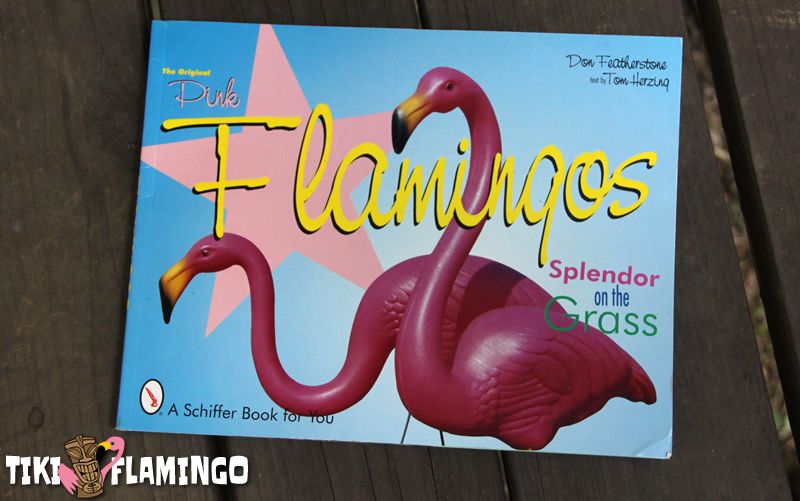
Make a Movie Night Gift Basket
For your more edgy friends, you could always put together a fun Pink Flamingos movie night gift basket. Along with the movie and a pair of plastic pink flamingos, you could include popcorn, a favorite adult beverage, a rubber chicken, and plastic dog doo!
Long Live the Plastic Flamingo!
The plastic pink flamingo is, more than anything, a symbol of Middle Class American hope and humor. Sticking the wire legs of a plastic flamingo into the ground is like an explorer planting a flag: it states to all that you have laid claim to that territory in the name of mirth, mischief, and goodwill.
It’s up to all of us to help keep the spirit of the plastic flamingo lawn ornament alive. Long Live the Plastic Flamingo Lawn Ornament!
